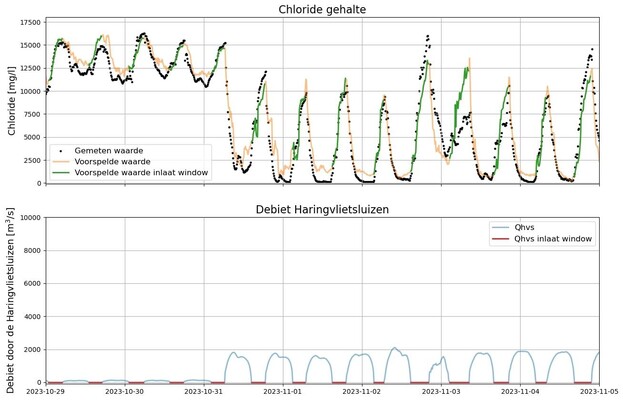Introduction
As part of the research program Onderzoeksprogramma Verzilting van Lerend Implementeren Kierbesluit Haringvlietsluizen, fish migration into the Haringvliet must be stimulated while maintaining feasible boundary conditions for inland salinity penetration. To support this, simulations and field studies are conducted to investigate salt dispersion in the Haringvliet estuary. A key parameter in this research is the salinity in the Haringvliet Outer Delta (‘Voordelta’), located on the sea side of the Haringvliet barrier. This barrier contains sluices that regulate inland water levels by periodically discharging freshwater into the Outer Delta, creating a stratified system. Additionally, these sluices will allow limited saltwater inflow to facilitate fish migration. The salinity at Stellendam-Buiten at -5m depth is particularly indicative of the water intake quality. Despite abundant measurement data, predicting salinity levels remains challenging, with existing methods such as 3D modeling being highly resource-intensive and costly.Objective and Methods
The extensive dataset on salinity levels in the Outer Delta offers the potential for leveraging Machine Learning (ML) models to improve predictive accuracy at a lower cost. This study investigates the feasibility of ML models in predicting complex estuarine salinity dynamics with minimal investment. Two ML models of varying complexity were developed. First, the predictive potential of the dataset was assessed using a simple decision tree model (Random Forest Regression), which demonstrated reasonable accuracy and was developed in just two days. Building on this, a more advanced decision tree-based model (Extreme Gradient Boosting) was implemented. The five-year dataset was divided into a training set (48 months), a calibration set (2.5 months), and a test set (3.5 months). Input parameters were selected through exploratory data analysis and Recursive Feature Elimination with Cross-Validation (RFECV).Results
The advanced model accurately predicted salinity levels in the Outer Delta with low computational cost, achieving a Mean Absolute Error (MAE) of 390 mg/L across the test dataset. Model performance depended primarily on the discharge rate of the Haringvliet sluices, identified as the most critical input parameter. The model showed the highest accuracy at low discharge rates (3000 m³/s), predicting slightly higher salinity peaks during non-discharge periods. However, under moderate discharge conditions (>1000 m³/s & 3000 m³/s), the model occasionally underestimated salinity peaks, which could pose safety risks. This research highlights the potential of ML applications for cost-effective and accurate prediction of salinity dynamics in estuarine environments. The model can be used in long-term predictions for the salinity levels in the Haringvliet Outer Delta and, under consideration, support decision support for sluice operators. The model can be improved significantly by considering the latest measurements of the salinity concentration as one of the input parameters. Furthermore, more complex ML models, such as deep learning models, might perform better at the expense of higher computational costs.
Predictive capability of the ML model with respect to the measurement data for the transition between a low sluice discharge regime to a high sluice discharge regime.










